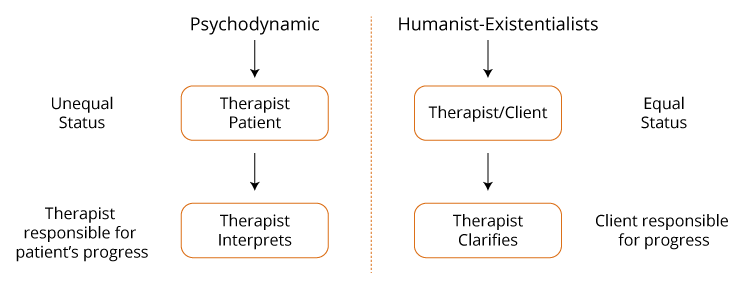Therapy
I’ve always been very dubious of therapist.
Finally learning what they are doing in PSYCH101.
There are many ways to do therapy:
- Psychodynamic
- Humanist-Existentialist
- Cognitive
- Behavioural
Psychodynamic Therapy
How to probe the unconscious:
- Dream Analysis
- Free Association, whereby the patient expresses their thoughts and feelings spontaneously and without censorship
For their part, the job of the psychoanalyst is to provide Interpretation. That is, the therapist explains the inner significance of thoughts, feelings, memories, and behaviour by analyzing the patient’s free associations and dreams.
But how does the therapist know if the interpretation is accurate? A key indication that progress is being made occurs when the patient begins to demonstrate Resistance. These are unconscious defensive maneuvers performed by the patient intended to hinder the progress of therapy. For example, the patient will begin to cancel therapy sessions, they might censor or fabricate their free associations, or they could become hostile towards the therapist. It’s as if the unconscious is trying to undermine the therapy in order to remain hidden. From this perspective, then, Resistance is a positive sign, an indication that the therapy is progressing.
Another indication of successful therapy, according to Freud, is Transference. This occurs when the patient unconsciously relates to the therapist in ways that simulate critical relationships in their life. For instance, the patient may begin to interact with the therapist as if he or she was a former spouse or a rejecting parent. The patient transfers their thoughts and feelings about these relationships to the therapist.

The therapist in turn encourages transference, sometimes even actively reenacting these relationships, because it provides the patient an opportunity to gain greater insight into their feelings, which can help them resolve their problems.
- For psychodynamic, they use the “patient” terminology implies that the therapist maintains higher status in the relationship.
- The therapist is responsible for the patient’s progress in therapy, and uses interpretation to reveal the hidden meaning behind the patient’s thoughts and feelings.
Humanist-Existentialism
- For humanist-existentialist, they use “client” terminology implies that the therapist and client share equal status in the relationship.
- it is the client who is responsible for the pace and direction of their therapy.

Cognitive Therapy
Behavioural Therapy
Behaviourist approaches to psychotherapy apply the principles of Classical Conditioning and Operant conditioning to modify problematic behaviour. From this perspective, the underlying root of a psychological condition is irrelevant.
To insight therapies, a maladaptive behaviour like substance abuse reflects an underlying problem that should be addressed. But to Behaviour Therapies, the maladaptive behaviour is the problem, so let’s just address the substance abuse.
There are 3 categories of behavioural therapy:
- Exposure Therapy
- Aversion Therapy
- Social Skills Training
